![]()
![]()
![]()
Use LEFT and RIGHT arrow keys to navigate between flashcards;
Use UP and DOWN arrow keys to flip the card;
H to show hint;
A reads text to speech;
86 Cards in this Set
- Front
- Back
- 3rd side (hint)
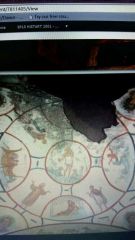
|
The Good Shephard, Story of Jonas, and Orants, from Catacomb of Saints Peter and Marcellinus, Rome, early 4th century, Roman, Early Christian |
Catacombs purchased by confraternity, cubicula with loculi carved out, lunettes depicting Jonah and ketos (prefiguration of Christ) |
|
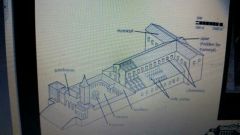
|
Old Saint Peter's, Rome, ca. 319-27, Roman, Early Christian |
|
|
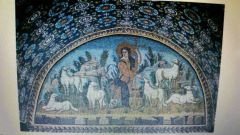
|
Christ as the Good Shephard mosaic from the Mausoleum of Galla Placidia, Ravenna, ca. 425, Roman, Early Christian |
Galla Placidia died near the time of construction, thought to be a tomb for her but actually probably for St. Lawrence. Showed earlier pre-Byzantine traditions of naturalism. Christ wearing purple, haloed, not carrying sheep but depicted with them. |
|
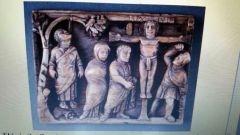
|
Suicide of Judas and Crucifixion ivory plaque from a box, c.420, Roman,Early Christian |
Beardless youth, very Greek heroic looking, not hanging but displayed on cross to contrast Judas' limp figure, Mary and Joseph on left, Longinus on right thrusting spear into his side |
|
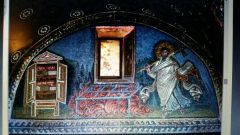
|
Martyrdom of Saint Lawrence, from Mausoleum of Galla Placidia, Ravenna, glass mosaic, ca. 425, Roman, Early Christian |
Codex on left, martyrdom of St. Lawrence depicted on right, haloed with cross and willingly taking the pain. "I'm well done on this side, turn me over!" |
|
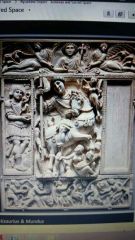
|
Justinian as World Conqueror (Barberini Ivory), mid-6 th century, Constantinople, ivory, Byzantine |
Barbarians, native animals and offerings on bottom, soldier bearing victory statue (nike) on left, jesus and angels approving on top, Justinian in the middle with fearful barbarian, victory nike, and bountiful Earth |
|
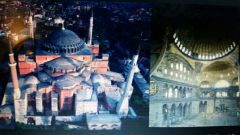
|
Anthemius of Tralles & Isodorus of Milletus, Hagia Sophia (Holy Wisdom), Constantinople (Istanbul), 532- 537, brick exterior with marble & mosaic interior, Byzantine |
Built by mathematician and physicist, uses light soo much, Procopius describes, big dome uses pendentives |
|
|
Monotheism |
The worshiping of one God |
|
|
|
Messiah |
The prophet purported by the Abrahamic religions to be the savior of all mankind |
|
|
|
Apostles |
Christ's twelve disciples |
|
|
|
Typology |
Presenting the Old Testament of the Bible to foreshadow Christ's life in the New Testament |
|
|
|
Nave |
The central area of an ancient Roman basilica or of a church, demarcated from aisles by piers or columns. |
|
|
|
Narthex |
A porch or vestibule of a church, generally colonnaded or arcaded and preceding the nave |
|
|
|
Transept |
The part of a church with an axis that crosses the nave at a right angle. |
|
|
|
Chancel Arch |
The arch which defines the apse of the church |
|
|
|
Altar |
The holy table in the apse where spiritual actions are carried out |
|
|
|
Relics |
The body parts, clothing, or objects associated with a holy person |
|
|
|
Ambulatory |
A covered walkway, outdoors or indoors; especially the passageway around the apse and the choir of a church (central plan church). |
|
|
|
Mausoleum |
A monumental tomb |
|
|
|
Orant |
In Early Christian art, a figure with both arms raised in the ancient gesture of prayer |
|
|
|
Codex |
Separate pages of vellum of parchment bound together at one side; the predecessor of the modern book. |
|
|
|
Pendentives |
A concave, triangular section of a hemisphere, four of which provide the transition from a square area to the circular base of a covering dome. |
|
|
|
Eucharist |
Body and Blood of Christ |
|
|
|
Intercessor |
One who intercedes; in a Christian context, usually an angel or saint. |
|
|
|
Icon |
A portrait or image; especially in Byzantine art, a panel with a painting of sacred personages that are objects of veneration |
|
|
|
Iconoclast |
Destroyers of images |
|
|
|
Iconophile/Iconodule |
Those who opposed the ban on icons |
|
|
|
Virgin Theotokos |
Greek name for "god-bearer" |
|
|
|
Christ Pantokrator |
Greek name for "all-powerful" |
|
|

|
Mosaics of Justinian & Theodora and attendants, from apse of San Vitale, Ravenna, Italy, ca. 547, Byzantine |
Justinian, at his right is Bishop Maximianus (responsible for San Vitale creation), chi-rho on shield of army, holding a bowl (paten). Theodora with wine waiting outside to follow huaband. Depicted as less important, but the fact that she is depicted at all shows her to have huge influence. |
|

|
Virgin (Theotokos) and Child enthroned, mosaic, apse of Hagia Sophia, Constantinople (Istanbul, Turkey), ca. 867, Byzantine |
Undid some iconoclasm, was a depiction of virgin mother and child, both frontal, but perspective of background at an angle, which contrasts the flatness of the robes. Signified the triumph of the iconophiles over the iconoclasts. |
|

|
Christ Blessing (Christ Pantokrator), Monastery of Saint Catherine, Mount Sinai, Egypt, 6th century, encaustic on wood, Byzantine |
|
|

|
Purse cover from Sutton Hoo ship burial, gold, garnet, & glass, ca. 625, Early Medieval, Anglo-Saxon |
Cloisonne, geometric and animal styles |
|
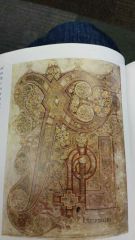
|
Chi-Rho-Iota (XPI) page, from the Book of Kells, ink, tempera, & gold and silver leaf, late 8th – early 9th century, Early Medieval, Hiberno-Saxon |
Human and animal designs but mostly abstract, Now this is how the birth of Christ came about. |
|
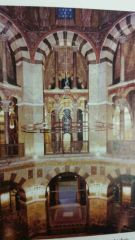
|
Odo of Metz (architect), Palatine Chapel of Charlemagne, Aachen, Germany, 792-805, Early Medieval, Carolingian |
Geometric voussoirs and westwork characterizing Romanesque architecture, Charlemagne would use it for church and meeting places, has his throne placed high above everyone else. |
|
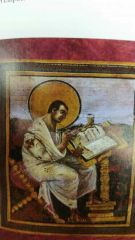
|
Saint Matthew, from Coronation Gospels, ca. 800-810, Early Medieval, Carolingian |
Classicizing, Charlamagne loved his books and commissioned this, purple, light and shade rather than line, author portrait |
|
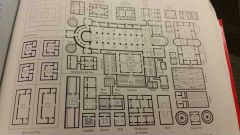
Designed to separate |
Schematic plan for a monastery, St. Gall, Switzerland, ca. 819, Early Medieval, Carolingian |
|
|
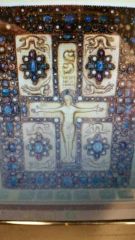
|
Crucifixion with Angels and Mourning Figures, Lindau Gospels cover, ca. 870, Early Medieval, Carolingian |
Repousse, contrast between Jesus and the weeping |
|
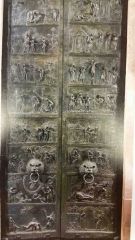
|
Bishop Bernward’s doors with relief panels, from St. Michael’s, Hildesheim, Germany, 1015, Early Medieval, Ottonian |
Left Genesis, right Jesus, shows original sin and redemption, typology |
|
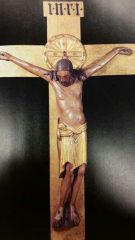
|
Gero Crucifix, Cologne Cathedral, Germany, ca. 970, Early Medieval, Ottonian |
Human depiction of Jesus, agonization |
|
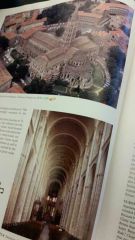
|
Saint-Sernin (Saint Saturninus), exterior and interior views, Toulouse, France, 1070-1120, Romanesque |
|
|
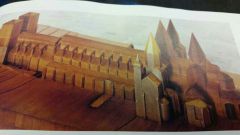
|
Restored view of Cluny III, Cluny, France, 1088-1130, Romanesque |
|
|
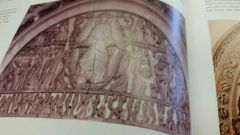
|
Giselbertus, tympanum with Last Judgment, west portal of Saint-Lazare, Autun, France, stone, 1120-1135, Romanesque |
|
|
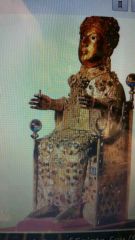
|
Reliquary statue of Sainte-Foy (Saint Faith), gold, silver gilt, jewels, & cameos over wooden core, late 10th -early 11th century, Romanesque |
|
|
|
Cloissone |
The decoration is formed by first adding compartments to the metal object by soldering or adhering silver or gold wires or thin strips placed on their edges. Purse cover from Sutton-Hoo |
|
|
|
Page purely for decoration |
Carpet Page |
|
|
|
Depiction of St. Matthew writing |
Author Portrait |
|
|
|
Ordinary people |
Laity
|
|
|
|
Middle part of church in monastery |
Cloister |
|
|
|
Pier |
A vertical, freestanding masonry support |
|
|
|
Transverse Arch |
An arch separating one vaulted bay from the next |
|
|
|
Engaged Columns |
A half-round column attached to a wall |
|
|
|
Almond-shaped |
Mandorla |
|
|
|
Embroidery |
The technique of sewing threads onto a finished ground to form contrasting designs. |
|
|
|
The battle that the Bayoux Tapestry depicts |
Battle of Hastings, 1066 |
|
|
|
opus modernum |
modern work - referring to Gothic art & architecture during its time |
|
|
|
Abbot Suger |
Designed Saint-Denis, the so-called first Gothic building |
|
|
|
A narrow arch |
Pointed arch |
|
|
|
New light |
lux nova |
|
|
|
Lancet Windows |
Tall narrow window ending in a pointed arch |
|
|
|
Oculus Windows |
Circular windows |
|
|
|
Triforium |
The blind arcaded gallery below the clerestory; occasionally filled with stained glass |
|
|
|
Came |
The lead strips in stained-glass windows that join separate pieces of colored glass |
|
|
|
Rayonnant Style |
The "radiant" style of Gothic architecture, dominant in the second half of the 13th century and associated with the French royal court of Louis IX at Paris |
|
|
|
Grisaille |
A monochrome painting done mainly in neutral grays to stimulate sculpture.
|
|
|
|
Pieta |
A painted or sculpted representation of the Virgin Mary mourning over the body of the dead Christ |
|
|
|
Altarpiece |
A panel, painted or sculpted, situated above and behind an altar. |
|
|
|
Repoussoir Figures |
Figures which have had attention directed onto them by means of certain techniques, such as having other figures direct their attention all toward the one. |
|
|
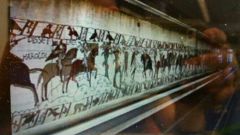
|
Bayeux Tapestry, from Bayeux Cathedral, Bayeux, France, wool embroidery on linen, 1070-1080, Romanesque |
|
|
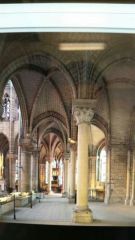
|
East End(ambulatory, radiating chapels, lux nova), Saint-Denis, France 1140-1144, Early Gothic |
|
|

|
Royal Portal, west façade, Chartres Cathedral, Chartres France, ca. 1145-1155, Early Gothic |
|
|
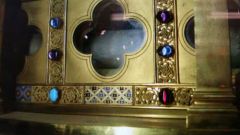
|
Relic of Mary’s cloth, Chartres Cathedral, Chartres France, Early Gothic |
|
|
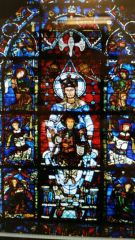
|
Virgin and Child and Angels (Notre Dame de la Belle Verrière), window in Chartres Cathedral, Chartres France, ca.1170, Early Gothic |
|
|
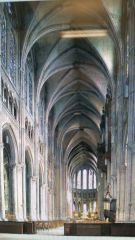
|
Chartres Cathedral, Chartres, France, as rebuilt after 1194, High Gothic: structure (ribbed groinvaulting, buttressing, tripartite elevation, lux nova) |
|
|
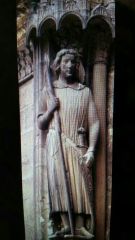
|
Chartres Cathedral, Chartres, France, as rebuilt after 1194, High Gothic: St. Theodore, jamb statue, south transept, ca. 1230 |
|
|
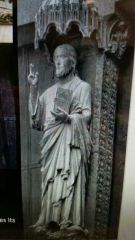
|
Beau Dieu, Amiens Cathedral, France ca. 1220-1235, High Gothic |
|
|
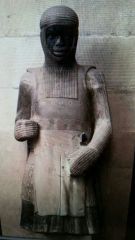
|
St. Maurice, MagdeburgCathedral, Germany. c. 1240-50, High Gothic |
|
|
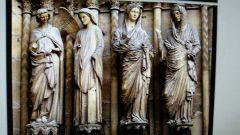
|
Annunciationand Visitation. Reims Cathedral, Reims, France. c.1230-1255, High Gothic |
|
|

|
Upper chapel, Sainte-Chapelle, Paris, France 1243-1248, High Gothic |
|
|
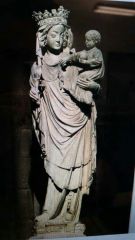
|
Virgin and Child (Virgin of Paris), Notre-Dame, Paris, France. early 14thcentury,High Gothic |
|
|
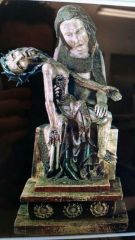
|
Röttgen Madonna, Rhineland, Germany. ca.1300-1325, Late Gothic |
|
|
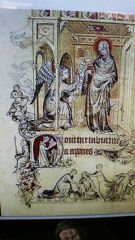
|
“Annunciation” in the Hours of Jeanne d’Evreux. ca.1325-28, High Gothic (dates fall in Late Gothic but it’s primarily in the courtly style) |
|
|
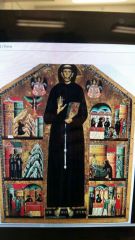
|
Bonaventura Berlinghieri, Saint Francis Altarpiece, 1235, Late Medieval/Early Renaissance Italy |
|
|
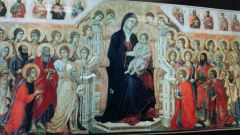
|
Duccio, Virgin and Child Enthroned with Saints, from the Maestà altarpiece,1308-1318, Late Medieval/Early Renaissance Italy |
|
|
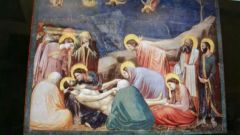
|
Giotto, Lamentation, from Scrovegni Chapel, Padua, Italy, 1305, Late Medieval/Early Renaissance Italy |
|
|
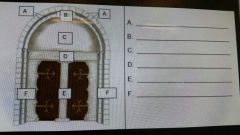
|
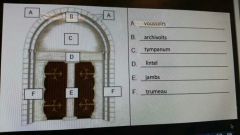
|
|

